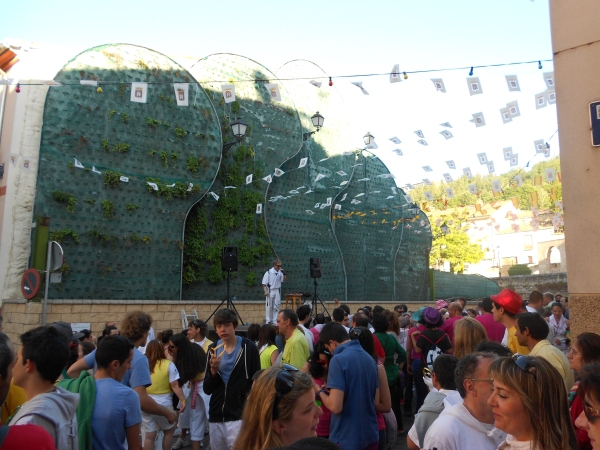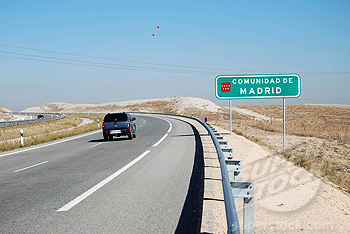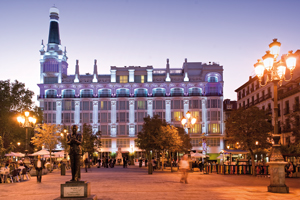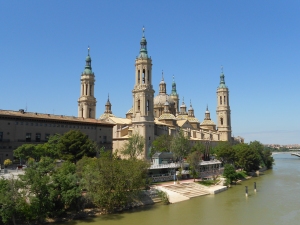On the 26th June, the wait was finally over – months of people telling us (the guiris) how crazy Soria would become during their fiestas, how unrecognisable the streets would be and how much we were sure to enjoy the Fiestas de San Juan. After three weeks of pre-Fiestas, it was time to see what all the fuss was about. Without further ado, here’s what happened during that epic week:
Miércoles el Pregón (Wednesday’s Announcement)
>We gathered in the Plaza Mayor to see the jurados of each cuadrilla (representatives of each of the 12 neighbourhoods in Soria) and heard the official start of the Fiestas – an announcement which ends ‘¡Viva Soria! ¡Viva Las Fiestas de San Juan!’
>Then, verbenas (mini-concerts) in plazas around the city!

Large crowds wait for the jurado and the band to emerge…and the big announcement.
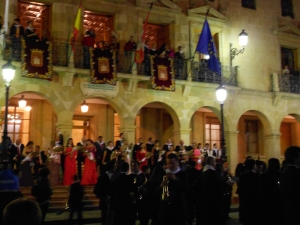
The jurados emerge. The announcement is made. The band and crowd rejoice.
Jueves La Saca (Thursday’s Release)
>Thursday was a bit of a struggle. We had to return to Monte Valonsadero to see the bulls being released from their corrals but to do so, we had to wait in the queue for the bus, nursing a hangover in the sweltering heat for 2 hours! The release of the bulls happened promptly at midday, was over within seconds giving us the rest of the afternoon to hang-out among the chiringuitos before the verbena later that evening.
*It’s worth mentioning that people were actually running with the bulls. From the photo below you can see that there were still a lot of fearless people in the area where the bulls were going to be released. There is, of course, very high risk of injury in doing so. I was happy to observe the goings-on from a safe distance.

The horsemen waiting to guide the bulls into Soria when they are released.

People leave Valonsadero…and their rubbish.
Viernes de Toros (Bull Friday)
>Day of the bull-fighting. Six of the bulls are killed in a morning session, the remaining six in the afternoon. I’m firmly against bull-fighting but I was intrigued to see my first and probably last set of bullfights. The atmosphere in the bullring was incredible: spectators in fancy dress, bands playing around the outside, the drinks were flowing and the sun was shining. The art of the bull-fighting was quite thrilling too, up until the point where they started to hurt the bull. From that point, it all got a bit uncomfortable.
>On either side of the sessions, it was dancing and drinking in the streets in the outdoor Zona – the strip of clubs in Soria that had moved their DJ sets outside for the occasion.

The bull is teased by multiple bullfighters before being killed.

Once killed, spectators jump into the ring to party.
Sábado Agés (Saturday…not sure what ‘Agés’ translates as!)
>This is the auctioning of the bull meat. Each neighbourhood auctions off every single part of their bull. We hopped around the various cuadrillas, regularly having wine from the bota (‘leather wine carrier’) squirted into our mouths.
>Later that evening, there were fireworks and more verbenas.

‘How much for the horns, mate?’

At another cuadrilla watching the bull meat being auctioned off.
Domingo de Calderas (Sunday’s Cauldrons)
>In the morning, the cuadrillas paraded again, this time with their calderas – individually-designed floats, many of which had the image of the bull incorporated into the design.
>There wasn’t much else going on during the day: indeed, the main events of the Fiestas happen in the first half of the week. That day, the language assistants of Soria just had a little picnic and enjoyed the sunshine. There was another verbena that night, but the consecutive nights of partying were beginning to take their toll and so we decided to sit that one out.
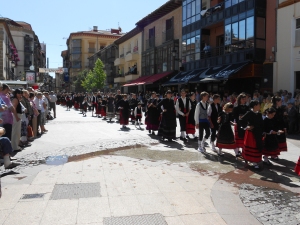
The 12 neighbourhoods parade their ‘calderas’ through the city in traditional dress.

One of the calderas.
Lunes de Bailas (Monday’s Dances)
>Our luck ran out on the last day of the Fiestas as there were thunderstorms before the main event! The threatening dark clouds meant we missed more parading in the city – a parade that led down to the River Duero. We met the crowds along the banks of the river a little later to join in with the festivities once the sky looked a little brighter. The crowd enjoyed the band playing sanjuaneras once again.
>In the evening, it was time to congregate in the Plaza Mayor in the same way we had started to mark the end of the Fiestas. The band played every single sanjuanera culminating in the final one with the line ‘ ¡Adiós, adiós, San Juan!’ We spent almost an hour and a half standing and squashed in with the crowd listening to these songs and by the end we were glad to get out and join the verbena for the last dance. This verbena had an added element of danger, however: people were holding and waving around hand-held fireworks.
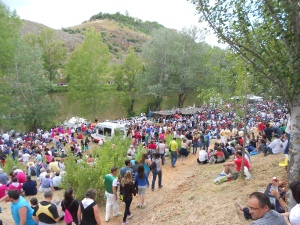
Partying down by the river.

The band play sanjuaneras much to the delight of the adoring crowd. .
It was a fitting way to bring my Year Abroad to an end, with one big epic street party. It was very much a celebration for the whole community: events around-the-clock to satisfy people of all ages and stamina-level (non-stop partying can be tiring you know!). During the week, I was bumping into friends, teachers I worked with, students, neighbours… I never knew whether that would be the last time I ever spoke to them. It was definitely a send-off like no other.
When I first arrived in Soria, I thought it would be quite a dead town, in that there weren’t very many people around and it had quite an ageing population. How things changed! We found the students, we found the ambiente, the sun came out and then suddenly the heart of Soria was beating harder and faster than ever before during its fiestas.
It was one of the most cultural, eye-opening experiences I had ever had in my life. Hundreds of people dancing in the street to outdoor bands, drinking calimocho – a red wine and coke mixture – with not a care in the world (apart from alcohol supplies running low, the music stopping and body exhaustion). Not bad for a country in crisis. Unthinkable in England.
But the Fiestas weren’t all about what we, anglophones, understand by the word – i.e. parties. The traditions surrounding the bulls, the parades in traditional dress and those sanjuaneras (San Juan songs) are the backbone of what is arguably one of the most story-like, cyclical Fiestas in Spain. You would never experience anything like this in Madrid or any other big city. These ‘village parties’ are more cultural and purer in smaller places, where participation is more widespread and traditions are greater preserved.
The Fiestas de San Juan were the perfect way to say goodbye to Soria and to Spain, and it definitely whetted my appetite to try and experience more Spanish fiestas when I return in the future. If I can time a future visit to Soria to coincide with the Fiestas, I would love to make it again but until then, I have the official poster here with me in England: a reminder of my Sorian experience on my bedroom door.

Official poster for the Fiestas de San Juan 2013
**For more information about the Fiestas (in Spanish), check out sanjuaneando.com.














